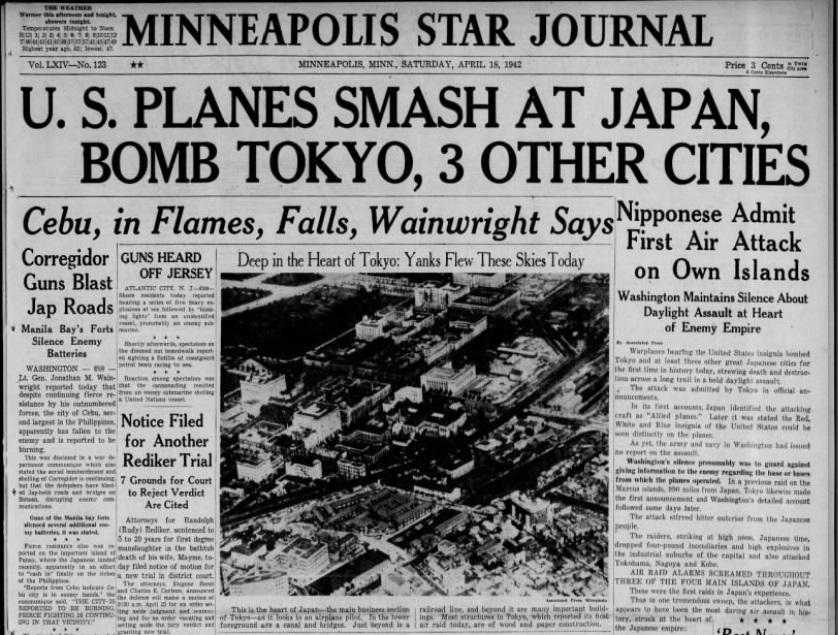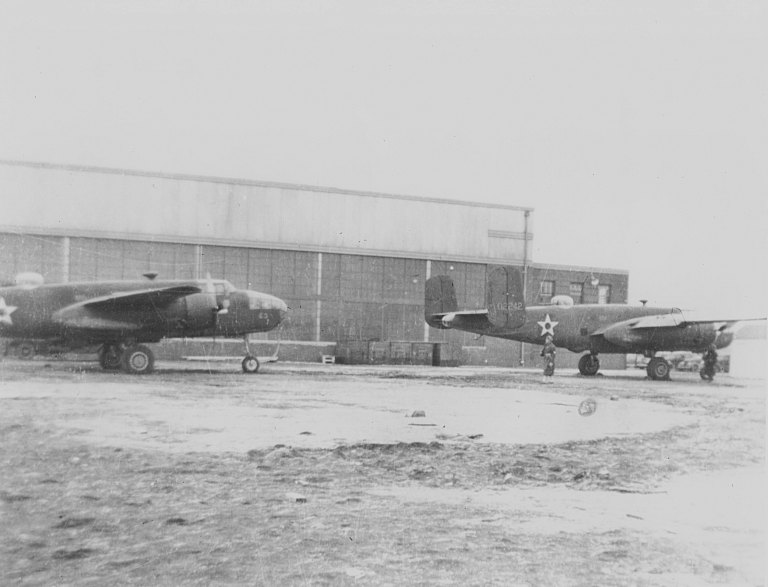On This Date In Twin Cities History - April 18, 1942

On this date in 1942, sixteen United States B-25B Mitchell medium bombers attacked Tokyo in the famous Doolittle Raid. The aircraft used in this raid were all modified at Wold-Chamberlain Field (now Minneapolis St. Paul International Airport) in February 1942 by local mechanics of Mid-Continent Airlines. The goal was to transform these medium-range aircraft into long-range cruisers in order to reach Tokyo.
Initial planning called for 20 aircraft to fly the mission, and 24 of the U.S. Airforce 17th Bombardment Group’s B-25B Mitchell bombers were diverted to the Mid-Continent Airlines modification center in Minneapolis. With support provided by two senior airline managers, Wold-Chamberlain Field’s maintenance hangar was the first modification center to become operational. The 710th Military Police Battalion, stationed at nearby Fort Snelling, provided tight security around the hangar during the modification work.
The mechanics in Minneapolis made a number of modifications to the B-25B Mitchell planes, most notably the removal of the lower gun turret, mounting of steel blast plates on the fuselage around the upper turret and the installation of a 160-gallon collapsible neoprene auxiliary fuel tank and support mounts for additional fuel cells in the bomb bay, crawl-way, and lower turret area. The modifications ultimately increased the bomber’s fuel capacity from 646 to 1,141 gallons.
Due to the secrecy of the mission, the Mid-Continent mechanics and the crew members of the 17th Bombardment Group were initially led to believe that the modifications were meant to enable the B-25Bs to fly on U-boat patrols off the Atlantic coast.
According to the book “Thirty Seconds Over Tokyo”, by Army Air Corps Capt. Ted Lawson, a member of the Doolittle Raid team, one morning in Minneapolis, Lt. Col. James Doolittle sent a trusted aide to gather up the pilots for a secret meeting. Capt. Davey Jones locked the door inside a Minneapolis hotel and told the men about an “important mission” that was under consideration by top military brass. Without giving the men any specific details, he asked for volunteers. Every man stepped forward.
Beginning March 1, 1942, the 24 crews flew the modified bombers from Wold-Chamberlain in Minneapolis to Eglin Field in Florida where they spent the next few weeks training for the mission.
On March 31st, sixteen of the B-25Bs were loaded onto the deck of the USS Hornet aircraft carrier in Alameda, California. The next day the carrier and rest of the task force shipped out. Once at sea, Doolittle gathered his volunteer crew together and finally revealed their mission to be a daring raid on Tokyo.
The raid was originally scheduled for a launch date of April 19th, however the task force encountered a Japanese fishing trawler on the morning of the 18th. Fearing it would radio the mainland with a warning, The USS Hornet’s commanding officer, Admiral William Halsey, and Doolittle decided to launch the raid 10 hours early and 400 miles further out to sea.
Doolittle and his pilots not only successfully launched from the USS Hornet, but they made it all the way to Japan. Nearly every bomber hit its primary targets and was met with surprisingly little Japanese fighter resistance.
After the raid, 15 of the 16 aircraft proceeded southwest off the southeastern coast of Japan and across the East China Sea toward eastern China. One bomber, piloted by Captain Edward J. York, was extremely low on fuel, and made the decision to head for the Soviet Union rather than be forced to ditch in the middle of the East China Sea. The remaining 15 aircraft reached the Chinese coast after 13 hours of flight and crash-landed or the crews bailed out.
Of the 80 crew members that participated in the raid that day, 77 survived the mission. Eight airmen were captured by the Japanese Army in China; three were later executed.


